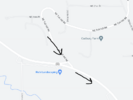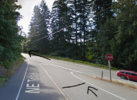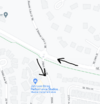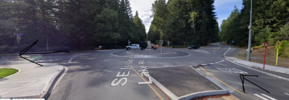I'm hopeful for this release to solve my two blocking turns. Other than these two turns, all my other turns are varying degrees of performance, but not for safety.
This one: It doesn't see well enough in both directions for this unprotected left. Picture doesn't capture just how steep it is coming to a stop (4% grade). It comes to a complete stop at the black line from the stop sign. This means the cameras are completely occluded from seeing oncoming traffic from the left or right which is 55 mph. It starts creeping and halfway to the oncoming traffic lane it decides to go, but it still doesn't have a good view left or right. Proper behavior at this turn would be to come to a complete stop 10 feet short of the oncoming traffic lane and then start creeping when it is clear.


and this roundabout: It starts and stops (aka lots of jerk in motion and rapid steering wheel movements) taking at least 4 times as long to navigate to the 3rd exit, even without traffic.


This one: It doesn't see well enough in both directions for this unprotected left. Picture doesn't capture just how steep it is coming to a stop (4% grade). It comes to a complete stop at the black line from the stop sign. This means the cameras are completely occluded from seeing oncoming traffic from the left or right which is 55 mph. It starts creeping and halfway to the oncoming traffic lane it decides to go, but it still doesn't have a good view left or right. Proper behavior at this turn would be to come to a complete stop 10 feet short of the oncoming traffic lane and then start creeping when it is clear.


and this roundabout: It starts and stops (aka lots of jerk in motion and rapid steering wheel movements) taking at least 4 times as long to navigate to the 3rd exit, even without traffic.




